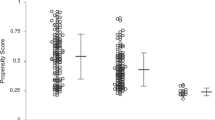Abstract
Based on 10 years' experience on more than 1500 patients, we present relevant data and discuss important aspects of a successful implementation of OPCAB. First, an intradepartmental debate about possible OPCAB strategies is necessary. A common strategy where patients are selected according to “OPCAB feasibility” or expected risk of HLM complications is from the theoretical viewpoint and according to our experience not recommendable. In order to implement OPCAB as a routine procedure in daily practice, great expertise of the surgeons, the anesthesiologists and the rest of the team, is necessary for the development of routines and to achieve good results. We recommend a decision-making algorithm where the first choice procedure and the alternatives are defined. We favor the “Total OPCAB Approach” where complete revascularization is performed with LIMA and sequential RIMA with T-graft insertion into the LIMA. Such a clear concept and the role model of the chief of the department, who provides also psychological safety, as well as a structured (codified) OPCAB technique, which is easy to adapt by others, are the most important factors ensuring a successful implementation process. A commitment of the main persons responsible in the department to such a concept becomes even more important because the OPCAB benefit is rarely noticeable in daily practice, but only in larger series. In our experience since 2005 it is remarkable that no stroke occurred directly postoperative and cardiac enzymes as well as other laboratory values like lactate dehydrogenase were significantly lower postoperative than after conventional CABG.
Zusammenfassung
Nach über 10-jährigen Erfahrung mit mehr als 1500 Bypassoperationen am schlagenden Herzen werden hier einige Aspekte, die uns für eine gelungene Implementierung des OPCAB-Verfahrens, wesentlich erscheinen, behandelt. Zunächst sollte man sich im Klaren darüber sein, welche der möglichen OPCAB-Strategien angewandt wird: eine Strategie, welche die Patienten für die OPCAB-Operationen danach selektiert, ob sie technisch für OPCAB geeignet erscheinen oder ein erhöhtes Risiko für die Anwendung der HLM tragen ist sowohl aus theoretischen Überlegungen als auch unserer Erfahrung nach nicht zu empfehlen. Vielmehr bedarf es für ein erfolgreiches OPCAB-Programm einer ausreichenden Expertise des Chirurgen, des Anästhesisten sowie des gesamten Teams, welche sich nur in der täglichen Routine bilden kann. Hier erscheint es uns sinnvoll einen Entscheidungs-Algorithmus aufzustellen, welcher definiert welche der möglichen Bypass-Techniken die Methode erster Wahl, und welches die mögliche Alternativen sind. Im dem bei uns favorisiertem „Total OPCAB Approach“ ist die Methode erster Wahl: OPCAB mit beiden LIMA und RIMA als Sequentialgraft in T-Graft-Technik ohne Manipulation der Aorta. Ein solches klares Konzept, welches von dem Chef der Abteilung mitgetragen oder besser vorgemacht wird, sowie eine gut strukturierte und entsprechend leicht erlernbare OPCAB-Methodik, sind die Hauptgaranten eines stabilen OPCAB-Programms. Eindeutige Positionierungen innerhalb der Abteilung sind umso wichtiger weil sich der OPCAB-Vorteil für den Patienten gegenüber dem konventionellen Verfahren in der täglichen Praxis kaum ersichtlich ist und wenn, dann nur nach statistischer Analyse größerer Serien zum Vorschein kommt. Bei uns fällt das vollständige Ausbleiben fokal neurologischer Defiziten unmittelbar nach der OP auf, sowie signifikant niedrigere Anstiege der Herzenzyme und der LDH postoperativ auf, bei Gleichheit bezüglich anderer Ergebnisparameter.
Similar content being viewed by others
References
Sellke FW, DiMaio JM, Caplan LR et al; American Heart Association (2005) Comparing on-pump and offpump coronary artery bypass grafting: numerous studies but few conclusions: a scientific statement from the American Heart Association council on cardiovascular surgery and anesthesia in collaboration with the interdisciplinary working group on quality of care and outcomes research. Circulation 111(21):2858–2864
Raja SG (2005) Pump or no pump for coronary artery bypass: current best available evidence. Tex Heart Inst J 32(4):489–501
Albert A, Ennker J (2007) Implementierungsstrategien des OPCAB-Verfahrens im Herzzentrum Lahr. Z Herz- Thorax- Gefäßchir 21:93–137
Albert A, Ennker J (2007) Bypassoperationen ohne Herz-Lungen-Maschine. Wege zur Implementierung als Routineverfahren. Z Herz- Thorax- Gefäßchir 21:39–43
Albert A, Peck EA, Wouters P, Van Hemelrijck J, Bert C, Sergeant P (2006) Performance analysis of interactive multimodal CME retraining on attitude toward and application of OPCAB. J Thorac Cardiovasc Surg 131(1):154–162
Sergeant P, Wouters P, Meyns B et al (2004) OPCAB versus early mortality and morbidity: an issue between clinical relevance and statistical significance. Eur J Cardiothorac 25(5):779–785
Albert A, Hassanein W, Ennker J (2007) Intra-clinic variation of OPCAB performance influences the incidence of postoperative renal failure. Implications for the evaluation and retraining of OPCAB. Clin Res Cardiol 95 (Suppl 1):S49–S57
Sharony R, Grossi EA, Saunders PC et al (2004) Propensity case-matched analysis of off-pump coronary artery bypass grafting in patients with atheromatous aortic disease. J Thorac Cardiovasc Surg 127(2):406–413
Lev-Ran O, Braunstein R, Sharony R et al (2005) No-touch aorta off-pump coronary surgery: the effect on stroke. J Thorac Cardiovasc Surg 129(2):307–313
Hammon JW, Stump DA, Butterworth JF et al (2006) Single crossclamp improves 6-month cognitive outcome in high-risk coronary bypass patients: the effect of reduced aortic manipulation. J Thorac Cardiovasc Surg 131(1):114–121
Kapetanakis EI, Stamou SC, Dullum MK et al (2004) The impact of aortic manipulation on neurologic outcomes after coronary artery bypass surgery: a risk-adjusted study. Ann Thorac Surg 78(5):1564–1571
Author information
Authors and Affiliations
Corresponding author
Rights and permissions
About this article
Cite this article
Albert, A., Ennker, J. 10-year experience with off-pump coronary artery bypass surgery at the Heart Institute Lahr/Baden. Z Herz- Thorax- Gefäßchir 21, 259–265 (2007). https://doi.org/10.1007/s00398-007-0595-z
Received:
Accepted:
Issue Date:
DOI: https://doi.org/10.1007/s00398-007-0595-z




